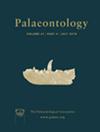化石位置的不准确并不会影响分化时间
IF 2.3
2区 地球科学
Q1 PALEONTOLOGY
引用次数: 0
摘要
时间尺度的系统发育支持了对跨越时间尺度的进化过程的探究,以及将这些过程与地球历史联系起来的尝试。通过推断化石的位置并使用它们的年龄作为时间约束,化石出生-死亡(FBD)过程下的尖端定年提供了一个连贯的分化时间先验。与此同时,它还将拓扑学和时间准确性联系起来,因为错误放置的化石终端会误导分化时间。这可能会给获得准确的节点年龄带来严重的问题,然而拓扑误差和时间误差之间的相互作用尚未得到彻底的探讨。我们模拟系统发育和相关形态学数据集使用的方法,包括进化在选择下,并对经验数据集基准。我们发现300个字符的数据集和真实缺失的数据水平通常可以成功地推断出化石在受限的现存主干拓扑结构上的正确位置,并且真实的节点年龄通常包含在贝叶斯后验分布中。虽然增加的化石采样提高了推断年龄的准确性,但拓扑和时间误差似乎并没有联系:在化石解析精度较低的分析中,节点年龄估计的误差并不会增加。同时,推断的散度时间是有偏差的,可能是由于FBD先验和我们模拟树的形状之间的不匹配。虽然这些结果令人鼓舞,表明即使是不确定亲和的化石也可以提供有用的时间信息,但它们也强调古生物学信息不能推翻模型先验和真实多样化历史之间的差异。本文章由计算机程序翻译,如有差异,请以英文原文为准。
Inaccurate fossil placement does not compromise tip-dated divergence times
Time-scaled phylogenies underpin the interrogation of evolutionary processes across deep timescales, as well as attempts to link these to Earth's history. By inferring the placement of fossils and using their ages as temporal constraints, tip dating under the fossilized birth–death (FBD) process provides a coherent prior on divergence times. At the same time, it also links topological and temporal accuracy, as incorrectly placed fossil terminals should misinform divergence times. This could pose serious issues for obtaining accurate node ages, yet the interaction between topological and temporal error has not been thoroughly explored. We simulate phylogenies and associated morphological datasets using methodologies that incorporate evolution under selection, and are benchmarked against empirical datasets. We find that datasets of 300 characters and realistic levels of missing data generally succeed in inferring the correct placement of fossils on a constrained extant backbone topology, and that true node ages are usually contained within Bayesian posterior distributions. While increased fossil sampling improves the accuracy of inferred ages, topological and temporal errors do not seem to be linked: analyses in which fossils resolve less accurately do not exhibit elevated errors in node age estimates. At the same time, inferred divergence times are biased, probably due to a mismatch between the FBD prior and the shape of our simulated trees. While these results are encouraging, suggesting that even fossils with uncertain affinities can provide useful temporal information, they also emphasize that palaeontological information cannot overturn discrepancies between model priors and the true diversification history.
求助全文
通过发布文献求助,成功后即可免费获取论文全文。
去求助
来源期刊

Palaeontology
地学-古生物学
CiteScore
5.60
自引率
3.80%
发文量
43
审稿时长
6 months
期刊介绍:
Palaeontology publishes a wide variety of papers on palaeontological topics covering:
palaeozoology
palaeobotany
systematic studies
palaeoecology
micropalaeontology
palaeobiogeography
functional morphology
stratigraphy
taxonomy
taphonomy
palaeoenvironmental reconstruction
palaeoclimate analysis and biomineralization studies.
 求助内容:
求助内容: 应助结果提醒方式:
应助结果提醒方式:


